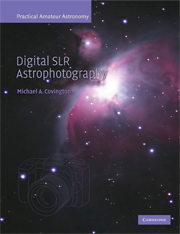Book contents
- Frontmatter
- Contents
- Preface
- Part I Basics
- Part II Cameras, lenses, and telescopes
- 5 Coupling cameras to telescopes
- 6 More about focal reducers
- 7 Lenses for piggybacking
- 8 Focusing
- 9 Tracking the stars
- 10 Power and camera control in the field
- 11 Sensors and sensor performance
- Part III Digital image processing
- Part IV Appendices
- Index
9 - Tracking the stars
Published online by Cambridge University Press: 21 August 2009
- Frontmatter
- Contents
- Preface
- Part I Basics
- Part II Cameras, lenses, and telescopes
- 5 Coupling cameras to telescopes
- 6 More about focal reducers
- 7 Lenses for piggybacking
- 8 Focusing
- 9 Tracking the stars
- 10 Power and camera control in the field
- 11 Sensors and sensor performance
- Part III Digital image processing
- Part IV Appendices
- Index
Summary
To take exposures longer than a few seconds, you must track the stars. That is, the telescope must compensate for the earth's rotation so that the image stays in the same place on the sensor while the earth turns.
This book is not the place to give a complete survey of the art of tracking and guiding; see Astrophotography for the Amateur and How to Use a Computerized Telescope. In this chapter I'll review the essentials, with an emphasis on recent developments.
Two ways to track the stars
Figure 9.1 shows the two major kinds of telescope mounts, altazimuth and equatorial. Until the 1980s, only an equatorial mount could track the stars; it does so with a single motor that rotates the telescope around the polar axis, which is parallel with the axis of the earth. In order to use an equatorial mount, you have to make the polar axis point in the right direction, a process known as polar alignment and long considered somewhat mysterious, although actually, correct polar alignment can be achieved quickly (see p. 102).
Computerized telescopes can track the stars with an altazimuth mount, or, indeed, a mount whose main axis points in any direction. During setup, the computer has to be told the exact positions of at least two stars. It then calculates how far to move along each axis, moment by moment, to compensate for the earth's rotation.
- Type
- Chapter
- Information
- Digital SLR Astrophotography , pp. 99 - 115Publisher: Cambridge University PressPrint publication year: 2007



